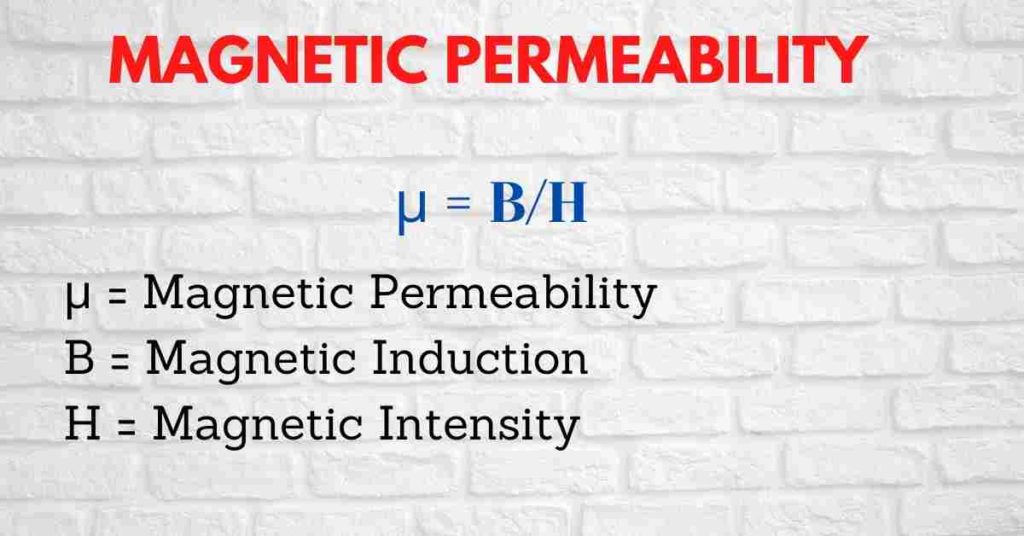Magnetic permeability refers to the ratio of magnetic induction to magnetic intensity. It is a scalar quantity and is represented by the symbol μ. Magnetic permeability is a measurement of a material’s resistance to the magnetic field or the extent to which a magnetic field can penetrate through a substance. Its unit is henries per meter (H/m), which can also be represented as newtons per ampere square.

Table of Contents
Magnetic Permeability Formula
Magnetic permeability is denoted as μ and can be expressed as μ = B/H, where B is the magnetic flux density, which is a measure of the real magnetic field within a material and is defined as the concentration of magnetic field lines of magnetic flux per unit cross-sectional area.
H stands for magnetic field strength, which is a measurement of the magnetizing field created by electric current flowing through a wire or coil.
Factors that Affect Magnetic Permeability
The factors affecting the magnetic permeability are as follows
- The nature of the material
- Humidity
- Position in the material
- Temperature
- The frequency of the applied force.
- Magnetic permeability is normally positive but can vary with the magnetic field.
Classification of Magnetic Materials
Based on the magnetic permeabilities, materials can be classified as follows:
Diamagnetic Material
Diamagnetic material has a constant relative magnetic permeability of somewhat less than 1. An example of a diamagnetic substance is bismuth, and when it is placed in a magnetic field, it partially expels the external magnetic field and lowers the magnetic flux density inside it. In addition, diamagnetism, by producing a magnetic field in opposition to an externally supplied magnetic field, produces a repelling effect.
Paramagnetic Material
Paramagnetic material has a constant relative permeability which is somewhat more than 1. Platinum is a paramagnetic substance that becomes magnetized in the direction of the external magnetic field when put in a magnetic field.
Ferromagnetic Material
The relative permeability of ferromagnetic materials is constant. Iron is an example of a ferromagnetic substance. As the magnetizing field increases, so does the relative permeability, which reaches a maximum and then declines. Many magnetic alloys, including pure iron, have a maximum relative permeability of 100,000 or higher.
Magnetic Permeability in Simple Words
Magnetic permeability is a measure of how easily magnetic fields can pass through a material. In simple terms, it describes the ability of a material to conduct magnetic lines of force.
Magnetic lines of force are invisible lines that describe the direction and strength of a magnetic field. When a magnetic field passes through a material, the material can either enhance or weaken the field, depending on its magnetic permeability.
Materials with high magnetic permeability, such as iron, can easily conduct magnetic lines of force and become strongly magnetized when placed in a magnetic field. This makes them useful for applications such as electromagnets, where strong magnetic fields are needed.
Materials with low magnetic permeability, such as air or vacuum, are not good conductors of magnetic fields and cannot become strongly magnetized. This property is important in the design of electrical and electronic equipment, where magnetic fields can interfere with the operation of sensitive components.
The magnetic permeability of a material is typically measured in units of henries per meter (H/m) or newtons per ampere squared (N/A^2). The value of magnetic permeability can be affected by factors such as temperature, pressure, and the presence of other magnetic fields.
Overall, magnetic permeability is an important property of materials that determines their ability to conduct magnetic fields, and it has many practical applications in technology and engineering.
Summary
- Magnetic permeability refers to the ratio of magnetic induction to magnetic intensity.
- Its unit is Henries per meter (H/m) which can also be represented as newtons per ampere square.
- The reflection, refraction, and velocity of radio wave signals as they travel through the Earth are all affected by magnetic permeability.
Related Topics
Direct Current
Alternating Current
Biot Savart Law: Statement, Derivation & Applications
is b2 paramagnetic or diamagnetic?
Magnetic Induction – An Overview
Frequently Asked Questions
1. What is electromagnetic force?
When a conductor is put in a magnetic field and current runs through it, the magnetic field and the current interact to create a force. This force is known as the “Electromagnetic force.” The direction of the current, magnetic force and flux are determined using Fleming’s left-hand rule.
2. Define magnetic pole?
The magnetic poles are the parts of the magnetic field where the magnet’s power is greatest. If a magnet is positioned in a free-turning position, it will rotate in a north-south direction. The north-seeking pole, or north pole, of the magnet, is the end that faces north.
3. Explain the interaction between electricity and magnetism?
Electromagnetism is the study of the interaction between magnetism and electricity. A magnet’s movement may create energy. A magnetic field may be created by the passage of electricity.
4. What are the types of magnets?
There are three main types of magnets: temporary, permanent, and electromagnets.
5. What is magnetic permeability?
The resistance of a material to a magnetic field, or the amount to which a magnetic field may permeate through a substance, is measured by magnetic permeability.
6. What is ampere’s law?
According to Ampere’s law, the integral of magnetic field density (B) along an imaginary line is equal to the product of free space permeability and current enclosed by the path.
More Interesting Topics
- BCl3 Lewis Structure in four simple steps - November 1, 2023
- PH3 Lewis Structure in four simple steps - October 8, 2023
- PF3 Lewis structure in four simple steps - September 24, 2023



